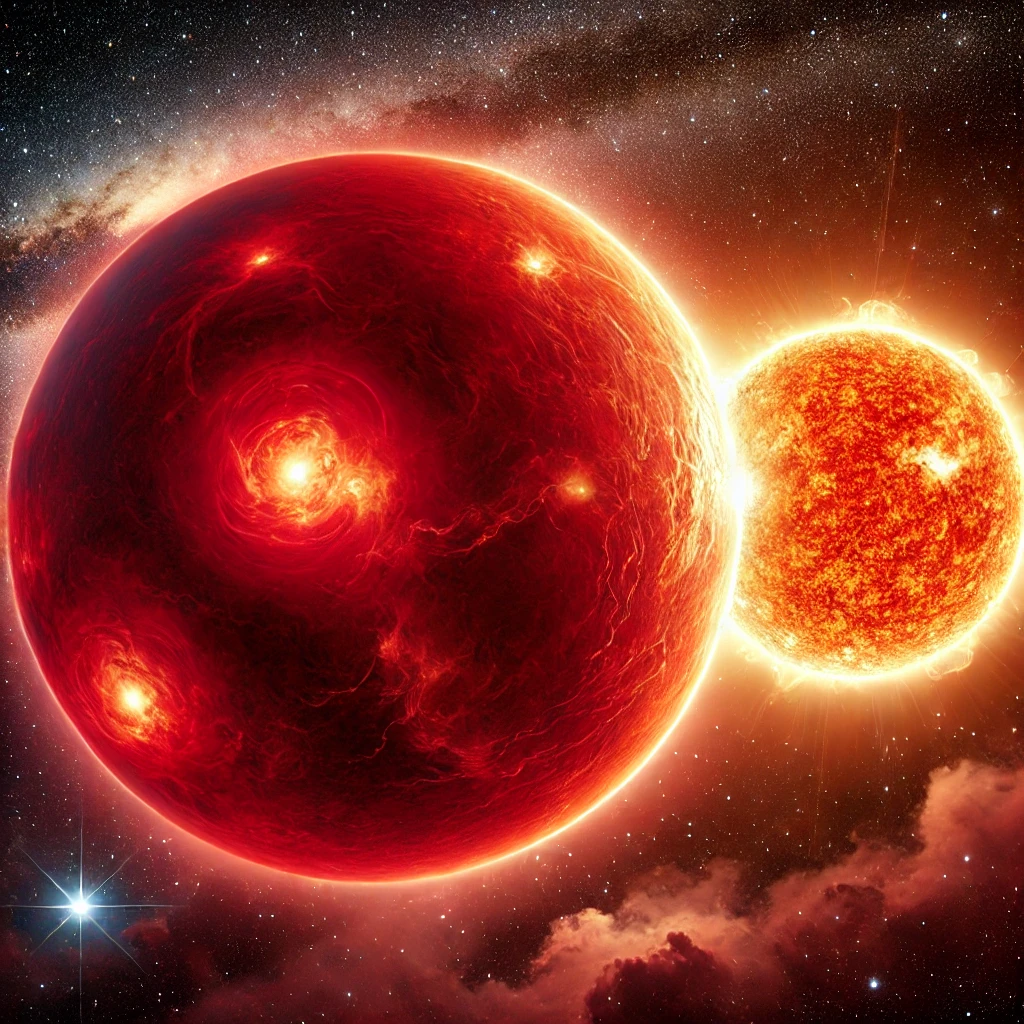Greetings, spacefarers. Captain Nova here, reporting from the heart of the cosmos.
Over the past few days, we’ve explored white dwarfs—the final stage for many Sun-like stars. But not all stars end their lives as quiet, fading remnants. Some live fast, burn bright, and die in spectacular explosions.
Today, we set our sights on the largest and most dramatic stars in the universe—red giants and supergiants. These are the monstrous beacons of the cosmos, shaping galaxies, forging elements, and leaving behind black holes, neutron stars, or planetary nebulae.
Fasten your harnesses, and let’s embark on today’s stellar journey.

What Are Red Giants?
A red giant is a star in its late life stage, after it has exhausted the hydrogen in its core. With no more fusion to support it, the core collapses under gravity, while the outer layers expand dramatically.
Despite their cool surface temperatures, red giants appear brilliantly luminous due to their enormous size.
Key Characteristics of Red Giants:
- Size: 10 to 100 times larger than the Sun
- Temperature: Cooler than the Sun (~3,000–4,000 K)
- Color: Reddish or orange
- Lifetime: A few million to a few billion years
How Red Giants Form
- Main Sequence Phase – A star like our Sun spends billions of years fusing hydrogen into helium.
- Hydrogen Depletion – The hydrogen in the core runs out, and the core begins to contract.
- Outer Expansion – The increased heat from the collapsing core causes the outer layers to expand.
- Helium Fusion – The core begins fusing helium into carbon and oxygen, generating new energy.
This phase is where our Sun will find itself in about 5 billion years. It will swell to engulf Mercury, Venus, and possibly Earth, becoming a massive, glowing red giant.
What Are Supergiants?
Supergiants are the largest and most powerful stars in the universe. They are many times more massive than the Sun, and their short, explosive lives shape entire galaxies.
Unlike red giants, which evolve from low- to medium-mass stars, supergiants form from massive stars—at least 8 to 100 times the Sun’s mass.
Key Characteristics of Supergiants:
- Size: 100 to 1,000 times larger than the Sun
- Brightness: Up to a million times more luminous than the Sun
- Color: Can be red (cooler) or blue (hotter)
- Lifetime: Only a few million years (very short compared to Sun-like stars)
Types of Supergiants:
- Red Supergiants – Cooler but enormous (e.g., Betelgeuse, Antares)
- Blue Supergiants – Hotter, more energetic (e.g., Rigel, Deneb)
Famous Red Giants and Supergiants in the Night Sky
1. Betelgeuse (Red Supergiant, Orion Constellation)
One of the most famous red supergiants, Betelgeuse, is nearing the end of its life. It is expected to explode as a supernova within the next 100,000 years—a cosmic blink of an eye.
2. Antares (Red Supergiant, Scorpius Constellation)
Antares is another massive, bloated red supergiant, glowing like a fiery ember in the night sky.
3. Rigel (Blue Supergiant, Orion Constellation)
Rigel is a blue supergiant, far hotter and more luminous than Betelgeuse. Despite being over 800 light-years away, it shines brilliantly in Orion’s constellation.
4. UY Scuti (One of the Largest Stars Known)
This gigantic red supergiant in the Milky Way is one of the largest known stars by volume, over 1,700 times the Sun’s diameter. If placed in our solar system, it would extend beyond Jupiter’s orbit.
What Happens When Red Giants and Supergiants Die?
Red Giants – Planetary Nebula and White Dwarf
- Low-mass stars (like the Sun) become red giants.
- They shed their outer layers into space, forming a planetary nebula.
- The leftover core shrinks into a white dwarf, slowly cooling over billions of years.
Supergiants – Supernova Explosions
- Massive stars can’t become white dwarfs—their cores are too massive.
- Instead, they explode as supernovae, creating elements like iron, gold, and uranium.
- The remnant can form a neutron star or a black hole, depending on mass.
These violent deaths spread heavy elements across space, seeding new star systems—including the one that eventually formed our Sun, Earth, and even life itself.
Could the Sun Become a Supergiant?
No. The Sun does not have enough mass to become a supergiant. It will only reach red giant status before shrinking into a white dwarf.
Only stars at least 8 times the Sun’s mass can become supergiants and explode as supernovae.
Why Do Supergiants Live Short Lives?
Despite their massive size, supergiants burn through their fuel incredibly fast. A star like the Sun can last 10 billion years, but a supergiant may only survive a few million years.
Because they fuse heavier elements quickly, their cores collapse rapidly, triggering a supernova explosion long before a Sun-like star even reaches old age.
What’s Next? The Formation of Black Holes
We’ve now followed the journey of stars from birth to death—but what happens when a star collapses into something so dense that not even light can escape?
Tomorrow, we explore black hole formation and the different types of black holes. These cosmic monsters are the ultimate enigma, warping time and space itself.
Until then, keep looking up, and remember—every bright star you see has a story to tell.
Captain Nova
Odyssey Explorer
Leave a Reply